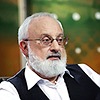Correcting Our Souls In Order To See Reality
 Kabbalistic books don’t contain even a single word that alludes to corporeal objects, places or even qualities that can be observed in this world. When we read phrases like “the Temple wall” or “man,” we must not imagine a wall in Jerusalem or a person in our world. Our world is an imagined reality, and Kabbalistic books do not say anything about the corporeal world.
Kabbalistic books don’t contain even a single word that alludes to corporeal objects, places or even qualities that can be observed in this world. When we read phrases like “the Temple wall” or “man,” we must not imagine a wall in Jerusalem or a person in our world. Our world is an imagined reality, and Kabbalistic books do not say anything about the corporeal world.
The spiritual world has no names, and that is why it is described using the language of branches. For instance, the excerpt: “And his feet shall stand on the Mount of Olives” means that the World of Infinity will spread (be revealed) and touch our world in the entirety of our desire.
The notion of “our world” also alludes to what we do not presently feel. The world we perceive is not defined in spirituality whatsoever, which is why it is called imaginary (Olam HaMedumeh). “Our world” or “this world” that’s described in Kabbalistic books is the last degree of the spiritual worlds. It is only our point in the heart that can be called a “point of this world,” because it is the last point of descent from above downward. If we tend to its development, then through this point we’ll be able to “ascend” back from below upwards.
We will then have the ability to perceive the world through the point in the heart, rather than from our corporeal senses. We will understand that this corporeal (illusory) life has been given to us as a temporary existence in an imaginary world. However, none of the Kabbalistic books (including the Bible, the Tanach, and others) ever actually mention this world.
The Bible doesn’t even speak of morality, despite what many people may think. It doesn’t speak of what I am to do with my animal body, but only of the correction of my soul. For example, the laws of the ritual bath (Mikveh) allude to the correction of the “body” (desires) by the qualities of Bina (water).
The laws of Kashrut (preparing food) tell us how to prepare one’s “animal” desire so it will be fit for being consumed by the “human” inside of us, or in other words, how to elevate one’s vegetative and animate desires to the “human” level inside of us.
Sacrifices in the Temple (Kurbanot) describe the process of drawing closer to the Creator (Kurban means “sacrifice,” and comes from the word Karov – “one who is near”) or how to utilize the desires of all levels to resemble the Upper Degree, and how to change one’s intention towards the Creator from “for one’s own sake” to “for the sake of bestowal.”
In our language, all of these writings appear to describe bread and meat burning atop an altar, or water and blood flowing from it, but in the language of branches, the subject is the correction of one’s intention. So don’t bother building any stone structures, but instead focus only on correcting your soul! Through these imaginary “corporeal” images, we must learn to see the spiritual forces behind them.

 Laitman.com Comments RSS Feed
Laitman.com Comments RSS Feed





~~~~
If there is a point in us that is our connection to the “real” world, (as opposed to this corporeal world of illusion), I’m wondering if everything in this world has some similar point. Even an illusion has to come from somewhere, yes? The picture on the movie screen is an illusion, but the light that comes from the projector is quite real, as is the projector (the source of the light) itself. Is the “illusory” world the same, then?